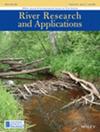在树冠稀疏的可涉水河流中采用横截面跟踪方法进行水文生境评估的性能和准确性
IF 1.7
4区 环境科学与生态学
Q4 ENVIRONMENTAL SCIENCES
引用次数: 0
摘要
本文以一次全面的河流恢复监测活动为基础,研究了用于水文地质调查的连续实时运动学(RTK)全球导航卫星系统(GNSS)定位跟踪的性能和准确性。这项研究的目的是评估该方法是否适用于在树冠稀疏、水流湍急的河流中高效地收集数据,并满足水管理部门对高效、低成本和稳健的勘测技术日益增长的需求。方法包括将人工横截面水深测量结果与通过对连续跟踪数据采用不同插值方法获得的水深估算结果进行比较。结果表明,两个数据集之间具有良好的一致性(R2 = 0.77,RMSE = 0.13 米)。当使用局部标准偏差滤波器去除有噪声的 RTK-GNSS 测量数据时,估算性能显著提高(R2 = 0.96,RMSE = 0.06 米)。滤波器对水文生境统计平均水深和变异系数的影响有限,但证明与水文地貌多样性的可达尺度评估相关。基于对 106 个 RTK-GNSS 定位日志的相关性分析,我们进一步评估了树冠对 RTK-GNSS 测量精度的影响,并观察到树冠边界 6.5 米范围内的影响很大。当树冠穿透力超过 1 米时,估计精度会明显下降,穿透力超过 4 米时,精度为 1 米的情况很常见。这项研究强调了 RTK-GNSS 跟踪所实现的效率提升,并展示了其在具有挑战性的条件下进行水文地貌勘测和溪流测量应用的潜力,使其成为传统方法和遥感技术的一种有前途的替代方法。本文章由计算机程序翻译,如有差异,请以英文原文为准。
Performance and accuracy of cross-section tracking methods for hydromorphological habitat assessment in wadable rivers with sparse canopy conditions
This article investigates the performance and accuracy of continuous Real-Time Kinematic (RTK) Global Navigation Satellite System (GNSS) position tracking for hydromorphological surveys, based on a comprehensive river restoration monitoring campaign. The aim of the research was to assess the method's suitability for efficient data collection in turbid, wadable rivers with sparse canopy conditions, and responds to the water management sector's increasing demand for efficient, low-cost, and robust survey techniques. The methodological approach involved comparing manual, cross-sectional water depth measurements to water depth estimations obtained by applying different interpolation methods to the continuous tracking data. The results demonstrate good agreement between both datasets (R2 = 0.77, RMSE = 0.13 m). When using a local standard deviation filter to remove noisy RTK-GNSS measurements, estimation performance increased significantly (R2 = 0.96, RMSE = 0.06 m). The filter's influence on the hydromorphological habitat statistics mean water depth and coefficient of variation was limited but proved to be relevant for reach-scale assessments of hydromorphological diversity. Based on a correlation analysis of >106 RTK-GNSS position logs, we furthermore assessed the impact of tree canopy on RTK-GNSS measurement accuracy and observed a strong influence within 6.5 m from the canopy border. Estimated accuracy deteriorated noticeably when canopy penetration exceeded 1 m, and accuracies >1 m were common beyond 4 m penetration. The study highlights the efficiency gains achieved with RTK-GNSS tracking, and showcases its potential for hydromorphological surveys and streamgaging applications in challenging conditions, making it a promising alternative to traditional methods and remote sensing techniques.
求助全文
通过发布文献求助,成功后即可免费获取论文全文。
去求助
来源期刊

River Research and Applications
环境科学-环境科学
CiteScore
4.60
自引率
9.10%
发文量
158
审稿时长
6 months
期刊介绍:
River Research and Applications , previously published as Regulated Rivers: Research and Management (1987-2001), is an international journal dedicated to the promotion of basic and applied scientific research on rivers. The journal publishes original scientific and technical papers on biological, ecological, geomorphological, hydrological, engineering and geographical aspects related to rivers in both the developed and developing world. Papers showing how basic studies and new science can be of use in applied problems associated with river management, regulation and restoration are encouraged as is interdisciplinary research concerned directly or indirectly with river management problems.
 求助内容:
求助内容: 应助结果提醒方式:
应助结果提醒方式:


